Structural Support 3D Printer Filaments
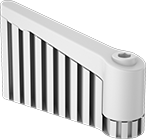
with your part to prevent the
part from losing its shape
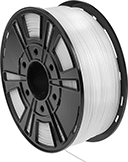
When 3D printing a model with overhangs or hollow spaces, use these filaments to prevent the model from losing its shape. They support the structure during the printing and cooling process, then dissolve or snap away once the part is hardened. Use them in dual-extrusion fused filament fabrication (FFF) printers alongside your primary filament. Unlike parts with supports printed from a single filament, there’s no cutting, sanding, or polishing required.
Choose a filament that has similar printing requirements as your primary filament. You will want to choose a support filament that prints at a similar temperature as your primary filament and has the same requirements for a heated build chamber, so they cool at the same rate and won’t warp. Aquasys 120 filaments are compatible with the widest variety of filament materials, but they require a heated build chamber.
You should also consider how you will remove the structural support filament from your finished part. Soluble filaments are well suited to print parts with complex or fragile designs as they gently dissolve off your primary part, leaving a smooth finish. Water-soluble filaments dissolve in a heated bath.
Spool | ||||||||||||
|---|---|---|---|---|---|---|---|---|---|---|---|---|
| Dia., mm | Printing Temp. | For Printer Bed Temp. | Hardness | Max. Exposure Temp. | Water Temp. to Dissolve | For Min. Nozzle Opening Dia., mm | Dia., mm | Dp., mm | Wt., g | For Use With | Each | |
Water Soluble | ||||||||||||
Aquasys 120—Clear Amber | ||||||||||||
| 1.75 | 220° to 245° C 430° to 470° F | 80° to 120° C 180° to 245° F | Rockwell C30 (Hard) | 80° C 176° F | 80° C 176° F | 0.4 | 200 | 55 | 500 | ABS Plastic ASA Plastic Nylon Plastic PETG Plastic Polypropylene Plastic TPU Plastic | 0000000 | 0000000 |
| 2.85 | 220° to 245° C 430° to 470° F | 80° to 120° C 180° to 245° F | Rockwell C30 (Hard) | 80° C 176° F | 80° C 176° F | 0.4 | 200 | 55 | 500 | ABS Plastic ASA Plastic Nylon Plastic PETG Plastic Polypropylene Plastic TPU Plastic | 0000000 | 000000 |
Wear-Resistant Nylon 3D Printer Filaments
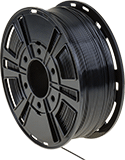
Print tough, long-lasting parts that won’t scratch or wear out from constant motion and friction, such as gears and washers. You can even tap or drill the parts without them cracking or shattering.
Use these filaments with fused filament fabrication (FFF) printers. Because of their relatively high melting point, a heated printer bed is recommended. These filaments also emit fumes when printing, so it’s best to use them in an enclosed printer or to remove the fumes with a fume exhauster. Store them in a sealed container with a desiccant so they don’t absorb moisture in the air, which can make them unusable.
Nylon 6/66 filaments are the strongest nylon filaments without a filler, but may warp while cooling.
Nylon 6/69 filaments stand up to chemicals for use in a variety of chemical processing applications. They’re also FDA Compliant 21 CFR 177.1395 and FDA Compliant 21 CFR 177.1500, so they can be used to produce parts that are intended for processing, handling, and packaging food and beverages.
Carbon-fiber-filled nylon filaments make rigid parts that are difficult to bend and break. Their parts can also be threaded and machined more easily than the same filaments without any filler. However, they’re abrasive, so only use them with abrasion-resistant nozzles.
Fiberglass-filled nylon filaments make strong parts that are less prone to warping or shrinking than the same filaments without any filler. However, they’re abrasive, so only use them with abrasion-resistant nozzles.
Tensile strength is the best measure of a filament's overall strength. Similar to the stress applied on a rope during a game of tug-of-war, it's the amount of pulling force a material can handle before breaking. A higher rating means a stronger filament. A tensile strength of 5,000 psi and above is considered good; 12,000 psi and above is excellent.
Maximum exposure temperature is the point at which a printed part will begin to deform. Above this temperature, your printed parts will start to lose structural integrity.
Spool | ||||||||||||
|---|---|---|---|---|---|---|---|---|---|---|---|---|
| Dia., mm | Printing Temp. | For Printer Bed Temp. | Tensile Strength | Hardness | Max. Exposure Temp. | Specifications Met | For Min. Nozzle Opening Dia., mm | Dia., mm | Dp., mm | Wt., g | Each | |
Nylon Plastic 6/66 | ||||||||||||
Black | ||||||||||||
| 1.75 | 255° to 275° C 491° to 527° F | 60° to 70° C 140° to 158° F | 8,700 psi (Good) | Durometer 60D (Medium) | 85° C 185° F | __ | 0.25 | 200 | 75 | 750 | 000000 | 000000 |
Nylon Plastic 6/69 | ||||||||||||
Black | ||||||||||||
| 2.85 | 250° to 255° C 482° to 491° F | 30° to 65° C 86° to 149° F | 8,100 psi (Good) | Not Rated | 82° C 180° F | FDA Compliant 21 CFR 177.1395, FDA Compliant 21 CFR 177.1500 | 0.2 | 200 | 70 | 1,000 | 0000000 | 00000 |
Off-White | ||||||||||||
| 2.85 | 250° to 255° C 482° to 491° F | 30° to 65° C 86° to 149° F | 8,100 psi (Good) | Not Rated | 82° C 180° F | FDA Compliant 21 CFR 177.1395, FDA Compliant 21 CFR 177.1500 | 0.2 | 200 | 70 | 1,000 | 0000000 | 00000 |
Carbon Fiber-Filled Nylon Plastic | ||||||||||||
Black | ||||||||||||
| 1.75 | 280° to 300° C 535° to 570° F | 50° C 122° F | 15,225 psi (Excellent) | Not Rated | 125° C 257° F | __ | 0.4 | 200 | 65 | 500 | 000000 | 00000 |
Fiberglass-Filled Nylon Plastic 6 | ||||||||||||
Gray | ||||||||||||
| 1.75 | 280° to 300° C 536° to 572° F | 25° to 50° C 77° to 122° F | 11,950 psi (Good) | Not Rated | 70° C 158° F | __ | 0.4 | 250 | 117 | 2,000 | 0000000 | 000000 |
| 2.85 | 280° to 300° C 536° to 572° F | 25° to 50° C 77° to 122° F | 11,950 psi (Good) | Not Rated | 70° C 158° F | __ | 0.4 | 250 | 117 | 2,000 | 0000000 | 000000 |
Dremel 3D Printer Filaments
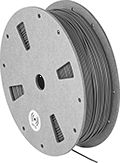
Build parts and prototypes from these filaments using Dremel fused filament fabrication (FFF) 3D printers. An RFID tag on the spool communicates with your printer, automatically adjusting it to the correct temperature and print speed for the filament material and notifying you when the filament is running out.
Nylon resists scratches and wear, and is often used to create parts that encounter constant friction such as gears or bearings. Nylon parts also won’t crack or shatter when they’re drilled or tapped. Exposure to humidity makes these filaments brittle and unusable, so they need to be stored in a sealed container with a desiccant. Like ECO-ABS, parts can warp during cooling and need a heated printer bed. Make sure your printer is connected to a ventilation system, as nylon emits fumes during printing.
Tensile strength is the best measure of a filament's overall strength. Similar to the stress applied on a rope during a game of tug-of-war, it's the amount of pulling force a material can handle before breaking. A higher rating means a stronger filament. A tensile strength of 5,000 psi and above is considered good; 12,000 psi and above is excellent.
Maximum exposure temperature is the point at which a printed part will begin to deform. Above this temperature, your printed parts will start to lose structural integrity.
Spool | ||||||||||||
|---|---|---|---|---|---|---|---|---|---|---|---|---|
| Manufacturer Model No. | Dia., mm | Printing Temp. | For Printer Bed Temp. | Tensile Strength | Max. Exposure Temp. | For Min. Nozzle Opening Dia., mm | Dia., mm | Dp., mm | Wt., g | Color | Each | |
Nylon Plastic | ||||||||||||
| DF45-NYP-B | 1.75 | 230° to 250° C 446° to 482° F | 80° C 176° F | 7,540 psi (Good) | 155° C 311° F | 0.4 | 180 | 55 | 500 | Black | 0000000 | 000000 |
Filament 3D Printers
Melt and extrude plastic filaments to build quick and inexpensive prototypes, custom and complex parts, and manufacturing aids such as jigs and fixtures. These 3D printers are also known as fused filament fabrication (FFF) and fused deposition modeling (FDM) printers. They meet U.S. and international standards for safety.
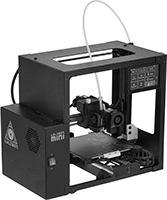
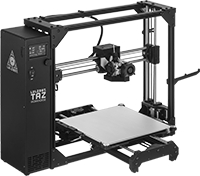
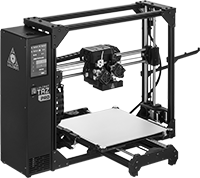
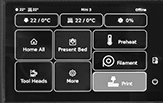

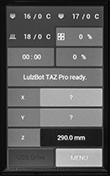
LulzBot printers are compatible with many different materials, so they’re useful across a wide range of applications. They have a minimum layer height that is twice as thin as MakerBot printers, meaning they print a finer level of detail. LulzBot printers come with open source software, so you can manually adjust temperature and print settings. All have heated printer beds to prevent parts from warping during cooling.
Mini 3 printers are the smallest in our offering but also the fastest; use them to quickly print small pieces. They have a magnetic bed which makes it easy to remove delicate prints without breaking them.
The TAZ Workhorse and TAZ Pro printer beds are reversible—prints adhere well to the PEI glass side, while the borosilicate glass side is especially flat for perfectly level prints. The TAZ Workhorse printers have the best combination of size and speed in our offering. The TAZ Pro printers are not as fast as the Mini 3 or the Workhorse, but have dual extruders so you can print structural supports. Dual extruders can also print two different colors into a single part.
Max. Printing | Printer Bed | Overall | ||||||||||||||
|---|---|---|---|---|---|---|---|---|---|---|---|---|---|---|---|---|
| Lg. | Wd. | Ht. | Min. Layer Ht., mm | Printer Speed, mm/s | Material | Type | Lg. | Wd. | Ht. | Accuracy, mm | Data Connection Type | Current, A | Voltage | Specifications Met | Each | |
Mini 3 | ||||||||||||||||
| 7" | 7" | 7" | 0.05 | 500 | PEI Glass | Heated, Magnetic | 18" | 13" | 24" | ±0.2 | USB-A | 3.2 | 120V AC, 240V AC | UL Listed, ETL Listed, C-ETL Listed, OSHW Certified, CSA Certified, CE Marked | 0000000 | 000000000 |
TAZ Workhorse | ||||||||||||||||
| 11" | 11" | 11 1/8" | 0.05 | 300 | Borosilicate Glass PEI Glass | Heated | 32 3/4" | 20" | 20 1/2" | ±0.2 | Standard SD Card, USB-A | 3.2 | 120V AC, 240V AC | UL Listed, ETL Listed, C-ETL Listed, OSHW Certified, CSA Certified, CE Marked | 0000000 | 00000000 |
TAZ Pro | ||||||||||||||||
| 11" | 11" | 11 1/8" | 0.05 | 200 | Borosilicate Glass PEI Glass | Heated | 32 5/8" | 28" | 20 1/2" | ±0.2 | USB-A | 3.2 | 120V AC, 240V AC | UL Listed, ETL Listed, C-ETL Listed, OSHW Certified, CSA Certified, CE Marked | 0000000 | 00000000 |
Plastic 3D Printer Powders

Produce intricate parts with these plastic powders—they don’t require support materials and have more uniform mechanical properties than filaments and resins. Use them with powder bed fusion (PBF) printing systems, such as selective laser sintering (SLS).
Nylon powders create long-lasting parts that resist wear and won't scratch from constant motion and friction. They resist UV light, so parts made from these powders are good for use outdoors. They also have good chemical resistance. Parts printed with these powders meet UL 94 HB, a strict standard for flammability.
Container | |||||||||||
|---|---|---|---|---|---|---|---|---|---|---|---|
| Color | Net Weight, kg | Type | Material | Particle Size | Tensile Strength, psi | Hardness | Max. Exposure Temp. | Flexural Modulus | Specifications Met | Each | |
| White | 20 | Bag | Plastic | 20-63 microns | 6,520 (Good) | Durometer 73D (Medium) | 75° C 167° F | 250,000 psi (Semi-Rigid) | UL 94 HB | 0000000 | 000000000 |
Colorants for Plastic Pellets

Add color when making plastic parts. Also called masterbatches, these colorants contain a base plastic that works with a variety of plastic types—from general purpose polypropylene to tough ABS. This means you don’t need to stock up on colorants for each type. Mix them in with your pellets before melting. To get a rich color for most plastic, you need only 1-2% of colorant in your batch, since they’re concentrated.
5 lbs. | |||
|---|---|---|---|
| Color | Maximum Temperature, °F | Each | |
For Use With ABS Plastic, Acetal Plastic, Nylon Plastic, PBT Plastic, Polycarbonate Plastic, Polyethylene Plastic, Polypropylene Plastic, Polystyrene Plastic, PVC Plastic | |||
| Black | 570° | 0000000 | 0000000 |
| Blue | 570° | 0000000 | 000000 |
| Dark Gray | 570° | 0000000 | 000000 |
| Gray | 570° | 0000000 | 000000 |
| Light Blue | 570° | 0000000 | 000000 |
| White | 570° | 0000000 | 000000 |
| Yellow | 570° | 0000000 | 000000 |
For Use With ABS Plastic, Nylon Plastic, PBT Plastic, Polystyrene Plastic, PVC Plastic | |||
| Orange | 570° | 0000000 | 000000 |
Wear-Resistant Plastic Pellets

With a low coefficient of friction, these pellets won't wear away from abrasion that’s often caused by contact with moving parts. Melt and mold them into desired shapes. All of these pellets are made from virgin resins and are compatible with various types of molding equipment, such as injection molders or 3D printers. They handle high temperatures without losing their mechanical properties.
Nylon pellets have good wear resistance, as well as chemical resistance against fuels and hydrocarbons. They will expand and contract when exposed to moisture and temperature changes.
Container | ||||||||||||
|---|---|---|---|---|---|---|---|---|---|---|---|---|
| Type | Net Weight, lbs. | Molding Temperature, °F | Melting Temperature, °F | Melt Flow Rate | Shrinkage | Hardness | Impact Strength | Tensile Strength | Coefficient of Friction | Clarity | Each | |
Nylon Plastic | ||||||||||||
Off-White | ||||||||||||
| Pail | 5 | 130° to 200° | 470° to 535° | Not Rated | 1.3-1.7% | Rockwell R115 (Hard) | 0.8 ft.-lbs./in (Poor) | 11,000 psi (Good) | 0.4 | Opaque | 0000000 | 0000000 |

























